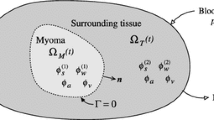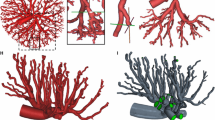Abstract
We present a computational model of the mechanics of growth of the trophoblast bilayer in a chorionic villous, the basic structure of the placenta. The placental trophoblast is modeled as a collection of elastic neutrally buoyant membranes (mononuclear cytotrophoblasts and multinucleated syncytiotrophoblast) filled with a viscous, incompressible fluid (cytoplasm) with sources of growth located inside cells. We show how this complex, dynamic fluid-based structure can be modeled successfully using the immersed boundary method. The results of our research presented here include simulations of two processes—cell proliferation and cell fusion which both play a crucial role in the growth and development of the trophoblast tissue. We present the computed results of simulations of both processes running independently as well as simultaneously, along with comparisons with clinically obtained results.
Similar content being viewed by others
References
Alberts, B., D. Bray, J. Lewis, M. Raff, K. Roberts and J. D. Watson (1994). Molecular Biology of the Cell, Garland Publishing.
Arthurs, K. M., L. C. Moore, C. S. Peskin, E. B. Pitman and H. E. Layton (1998). Modeling arteriolar flow and mass transport using the immersed boundary method. J. Comput. Phys. 147, 402–440.
Batchelor, G. K. (1967). An Introduction to Fluid Dynamics, Cambridge Press.
Benirschke, K. and P. Kaufmann (1995). Pathology of the Human Placenta, Springer.
Bottino, D. C. (1998). Modeling viscoelastic networks and cell deformation in the context of the immersed boundary method. J. Comput. Phys. 147, 86–113.
Bottino, D. C. and L. J. Fauci (1998). A computational model of ameboid deformation and locomotion. Eur. Biophys. J. 27, 532–539.
Boyd, J. D. and W. J. Hamilton (1970). The Human Placenta, Cambridge: W. Heffer & Sons, Ltd.
Chicurel, M. E., Ch. S. Chen and D. E. Ingber (1998). Cellular control lies in the balance of forces. Curr. Opin. Cell Biol. 10, 232–239.
Cortez, R. and M. Minion (2000). The Blob projection method for the immersed boundary problems. J. Comput. Phys. 161, 428–453.
Davidson, L. A., M. A. R. Koehl, R. Keller and G. F. Oster (1995). How do see urchins invaginate? Using biomechanics to distinguish between mechanisms of primary invagination. Development 121, 2005–2018.
Dillon, R. H. and L. J. Fauci (2001). A fluid-structure interaction model of ciliary beating, in Computational Modeling in Biological Fluid Dynamics, The IMA Volumes in Mathematics and its Applications 124, L. J. Fauci and S. Gueron (Eds), Springer, pp. 71–80.
Dillon, R. and L. Fauci (2000a). A microscale model of bacterial and biofilm dynamics in porus media. Biotechnol. Bioeng. 68, 536–547.
Dillon, R. and L. Fauci (2000b). An integrative model of internal axoneme mechanics and external fluid dynamics in ciliary beating. J. Theor. Biol. 207, 415–430.
Dillon, R., L. J. Fauci, A. Fogelson and D. Gaver (1996). Modeling biofilm processes using the immersed boundary method. J. Comput. Phys. 129, 57–73.
Dillon, R., L. J. Fauci and D. Gaver III (1995). Microscale model of bacterial swimming, chemotaxis and substrate transport. J. Theor. Biol. 177, 325–340.
Dillon, R. and H. G. Othmer (1999). A mathematical model for outgrowth and spatial pattering of the vertebrate limb bud. J. Theor. Biol. 197, 295–330.
Fauci, L. J. (1990). Interaction of oscillating filaments: a computational study. J. Comput. Phys. 86, 294–313.
Fauci, L. J. and A. L. Fogelson (1993). Truncated Newton Method and the Modeling of Complex Immersed Elastic Structures. Communication on Pure and Applied Mathematics, XLVI, pp. 787–818.
Fauci, L. F. and C. S. Peskin (1988). A computational model of aquatic animal locomotion. J. Comput. Phys. 77, 85–107.
Fogelson, A. L. (1984). A mathematical model and numerical method for studying platelet adhesion and aggregation during blood clotting. J. Comput. Phys. 56, 111–134.
Honore, L. H., F. J. Dill and B. J. Poland (1976). Placental morphology in spontaneous human abortuses with normal and abnormal karyotypes. Teratology 14, 151–166.
Jung, E. and C. S. Peskin (2001). 2-D simulations of valveless pumping using the immersed boundary method. SIAM J. Sci. Comput. 23, 19–45.
Kliman, H. J. (1999). Trophoblast to Human Placenta, Encyclopedia of Reproduction 4, E. Knobil and J. D. Neill (Eds), Academic Press.
Kliman, H. J., M. A. Feinman and J. F. Strauss III (1987). Differentiation of human cytotrophoblast into syncytiotrophoblast in culture. Trophoblast Res. 4, 407–421.
Kliman, H. J. and L. French (2001). Trophoblast inclusions are associated with karyotypic abnormalities. 21st Annual Meeting of the Society for Maternal-Fetal Medicine, Reno, NV.
Kliman, H. J., J. E. Nestler, E. Sermasi, J. M. Sanger and J. F. Strauss III (1986). Purification, characterization and in vitro differentiation of cytotrophoblasts from human term placentae. Endocrinology 118, 1567–1582.
Kliman, H. J. and L. Segel (2003). The placenta may predict the baby. J. Theor. Biol. 225, 143–145.
Kliman, H. J., L. Segel, L. Fauci and R. Cortez (2001). Model for the formation of trophoblast inclusions in chorionic villi. 21st Annual Meeting of the Society for Maternal-Fetal Medicine, Reno, NV.
Lewis, S. H. and E. Perrin (1999). Pathology of the Placenta, Churchill Livingstone.
Mayhew, T. M. (2001). Villous trophoblast of human placenta: a coherent view of its turnover, repair and contribution to villous development and maturation. Histol. Histopathol. Cell. Mol. Biol. 16, 1213–1224.
McQueen, D. M. and C. S. Peskin (1989). A three-dimensional computational method for blood flow in the heart. II. Contractible fibers. J. Comput. Phys. 82, 289–297.
Novak, R., D. Agamanolis, S. Dasu, H. Igel, M. Platt, H. Robinson and B. Shehata (1998). Histologic analysis of placental tissue in first trimester abortions. Pediatr. Pathol. 8, 477–482.
Peskin, C. S. (1972). Flow patterns around heart valves: a numerical method. J. Comput. Phys. 10, 252–271.
Peskin, C. S. (1977). Numerical analysis of blood flow in the heart. J. Comput. Phys. 25, 220–252.
Peskin, C. S. (2002). The immersed boundary method. Acta Numerica, 1–39.
Peskin, C. S. and D. M. McQueen (1995). A general method for computer simulation of biological systems interacting with fluids, in Biological Fluid Dynamics, vol. 19, C. P. Ellington and T. J. Pedley (Eds), Cambridge Press, pp. 265–276.
Peskin, C. S. and D. M. McQueen (1989). A three-dimensional computational method for blood flow in the heart. I. Immersed elastic fibers in a viscous incompressible fluid. J. Comput. Phys. 81, 327–405.
Rejniak, K. A. (2002). A computational model of the mechanics of growth of a trophoblast tissue, PhD thesis, Tulane University, New Orleans, USA.
Silvestre, E., V. Cusi, M. Borras and J. Anitch (1996). Cytogenetic and morphologic findings in chorionic villi from spontaneous abortions. Birth Defects; Original Article Series 30, 353–357.
Van Essen, D. C. (1997). A tension-based theory of morphogenesis and compact wiring in the central nervous system. Nature 285, 313–318.
Author information
Authors and Affiliations
Corresponding author
Rights and permissions
About this article
Cite this article
Rejniak, K.A., Kliman, H.J. & Fauci, L.J. A computational model of the mechanics of growth of the villous trophoblast bilayer. Bull. Math. Biol. 66, 199–232 (2004). https://doi.org/10.1016/j.bulm.2003.06.001
Received:
Accepted:
Issue Date:
DOI: https://doi.org/10.1016/j.bulm.2003.06.001




